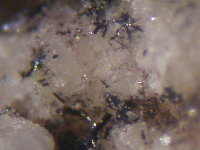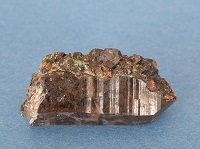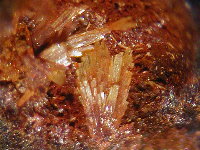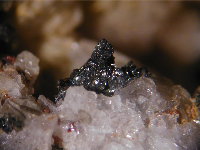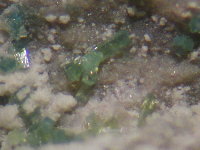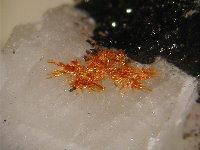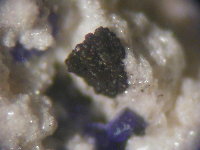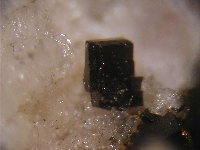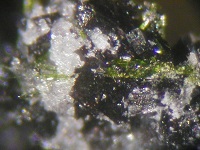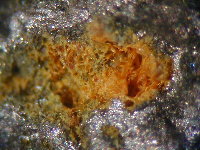|
|
|
|
|
|
|
|
|
|
|
|
MINERAL CLASSIFICATION / SYSTEMATIK der MINERALE
based on E.H. Nickel & M.C. Nichols (2009), H. Strunz & E.H. Nickel (2001),
revised by Thomas Witzke (2022)
4. OXIDES, HYDROXIDES
(Oxides, Hydroxides, V[5,6]-Vanadates, Arsenites, Antimonites, Bismutites, Sulfites, Selenites, Tellurites, Iodates)
4.J: Arsenites, Antimonites, Bismuthites
|
|
4.JA. Neso-Arsenites, Antimonites and Bismuthites |
| |
|
4.JA.005. Reinerite |
| |
| |
Reinerite | |
Zn3(AsO3)2 | |
orth., Pbam | |
| |
G |
|
|
4.JA.010. Trigonite |
| |
| |
Trigonite | |
Pb3Mn(AsO3)2(AsO2OH) | |
mon., Pn | |
| |
G |
|
|
4.JA.015. Gabrielsonite |
| |
| |
Gabrielsonite | |
PbFe3+(AsO3)O | |
orth., P21ma | |
| |
IMA 1966-011, Rd |
| |
Gabrielsonite, originally described as PbFe(AsO4)(OH) and as a
member of the Descloizite group (or supergroup), was redefined as an arsenite (IMA 17-G). The mineral shows
some structural relation, but is not a member of this supergroup.
|
|
|
4.JA.020. Chadwickite |
| |
| |
Chadwickite | |
(UO2)HAsO3 | |
tetr. | |
| |
IMA 1997-005 |
|
|
4.JA.025. Derbylite group |
| |
| |
Derbylite | |
Fe3+4Ti3Sb3+O13(OH) | |
mon., P21/n | |
FOTO | |
G |
| |
Tomichite | |
(V,Fe3+)4Ti3As3+O13(OH) | |
mon., A2/m | |
| |
IMA 1978-084 |
| |
Graeserite | |
Fe4Ti3AsO13(OH) | |
mon., A2/m | |
| |
IMA 1996-010 |
|
|
4.JA.030. Hemloite |
| |
| |
Hemloite | |
(Ti,V,Fe)12(As,Sb)2O23(OH) | |
tric., P1 | |
| |
IMA 1987-015 |
|
|
4.JA.035. Zimbabweite |
| |
| |
Zimbabweite | |
Na(Pb,Na,K)2(Ta,Nb,Ti)4As4O18 | |
orth., Ccmb | |
| |
IMA 1984-034 |
|
|
4.JA.040. Finnemanite |
| |
| |
Finnemanite | |
Pb5(AsO3)3Cl | |
hex., P63/m | |
| |
G |
|
|
4.JA.045. Georgiadesite |
| |
| |
Georgiadesite | |
Pb4(AsO3)Cl4(OH) | |
mon., P21/c | |
| |
G |
|
|
4.JA.050. Freedite |
| |
| |
Freedite | |
CuPb8(AsO3)2O3Cl5 | |
mon., C2/m | |
| |
IMA 1984-012 |
|
|
4.JA.055. Magnussonite group |
| |
| |
Magnussonite | |
Mn2+19As3+12O36(OH,Cl)2 | |
cub., Ia3d | |
| |
Rd |
| |
Brattforsite | |
Mn2+19As3+12O36Cl2 | |
mon., C2/c | |
| |
IMA 2019-127 |
| |
Magnussonite: anion-deficient derivative of the fluorite structure, with AsO3 groups. Brattforsite is structurally related
to Magnussonite.
|
|
|
4.JA.060. Armangite |
| |
| |
Armangite | |
Mn2+26[As3+6(OH)4O14][As3+6O18](CO3) | |
trig., P3 | |
| |
G |
| |
Armangite: anion-deficient derivative of the fluorite structure, with AsO3 groups.
|
|
|
4.JA.065. Cafarsite |
| |
| |
Cafarsite | |
(Ca,Na,□)19Ti3Fe3+4Fe2+4(AsO3)28F | |
cub., Pn3 | |
FOTO | |
IMA 1965-036, Rd |
|
|
4.JA.070. Nanlingite |
| |
| |
Nanlingite | |
Na(Ca5Li)Mg12(AsO3)2[Fe2+(AsO3)6]F14 | |
trig., R3m or R3m | |
| |
A |
|
|
4.JA.075. Rouseite |
| |
| |
Rouseite | |
Pb2Mn(AsO3)2·2H2O | |
tric., P1 or P1 | |
| |
IMA 1984-071 |
|
|
4.JA.080. Seelite group |
| |
| |
Seelite | |
Mg(UO2)2(AsO3,AsO4)2·7H2O | |
mon., C2/m | |
| |
IMA 1992-005 |
| |
Dymkovite | |
Ni(UO2)2(AsO3)2·7H2O | |
mon., C2/m | |
| |
IMA 2010-087 |
|
|
4.JA.085. Nealite |
| |
| |
Nealite | |
Pb4Fe(AsO3)2Cl4·2H2O | |
tric., P1 | |
FOTO | |
IMA 1979-050 |
|
|
| |
| |
|
4.JB. Neso-Arsenites, Antimonites and Bismuthites, with additional anions
(BO3, SO4, SiO4 etc.) |
| |
|
4.JB.005. Tooeleite |
| |
| |
Tooeleite | |
Fe6(AsO3)4(SO4)(OH)4·4H2O | |
mon., C2/m | |
| |
IMA 1990-010 |
|
|
4.JB.010. Szklaryite [Dumortierite supergroup] |
| |
| |
Szklaryite | |
Al6BAs3+3O15 | |
orth., Pbcm | |
| |
IMA 2012-070 |
|
|
4.JB.015. Ekatite |
| |
| |
Ekatite | |
(Fe,Fe2+,Zn)12(AsO3)6(AsO3,SiO3OH)2(OH)6 | |
hex., P63mc | |
| |
IMA 1998-024 |
|
|
4.JB.020. Asbecasite |
| |
| |
Asbecasite | |
Ca3(Be,B)2(Ti,Sn,Fe)As3+6Si2O20 | |
trig., P3c1 | |
| |
IMA 1965-037 |
|
|
| |
| |
|
4.JC. Soro-Arsenites, Antimonites and Bismuthites |
| |
|
4.JC.005. Paulmooreite |
| |
| |
Paulmooreite | |
Pb2As2O5 | |
mon., P21/a | |
| |
IMA 1978-004 |
| |
Paulmooreite: with As2O5 dimers of two corner-sharing
AsO3 pyramides.
|
|
|
4.JC.010. Fetiasite |
| |
| |
Fetiasite | |
(Fe2+,Fe3+,Ti4+)3O2As2O5 | |
mon., P21/m | |
FOTO | |
IMA 1991-019 |
| |
Fetiasite: with As2O5-dimers.
|
|
|
4.JC.015. Bianchiniite |
| |
| |
Bianchiniite | |
Ba2(TiV)(As2O5)2OF | |
tetr., I4/mcm | |
| |
IMA 2019-022 |
| |
Bianchiniite: with As2O5-dimers.
|
|
|
4.JC.020. Gebhardite |
| |
| |
Gebhardite | |
Pb8O(As2O5)2Cl6 | |
mon., P21/c | |
| |
IMA 1979-071 |
| |
Gebhardite: with As2O5-dimers.
|
|
|
4.JC.025. Vajdakite |
| |
| |
Vajdakite | |
(Mo6+O2)2As3+2O5·3H2O | |
mon. | |
FOTO | |
IMA 1998-031 |
|
|
4.JC.030. Prachařite |
| |
| |
Prachařite | |
CaSb5+2(As3+2O5)2O2·10H2O | |
trig., P3c1 | |
| |
IMA 2018-081 |
|
|
4.JC.035. Schneiderhöhnite |
| |
| |
Schneiderhöhnite | |
Fe2+Fe3+3As3+5O13 | |
tric., P1 | |
| |
IMA 1973-046 |
| |
With As2O5 dimers and single AsO3
groups (Cooper & Hawthorne, 2016, Can. Min. 54, 707).
|
|
|
4.JC.040. Ludlockite |
| |
| |
Ludlockite | |
PbFe3+4As3+10O22 | |
tric., A1 | |
FOTO | |
IMA 1969-046 |
| |
Ludlockite: five corner-sharing AsO3 pyramides forming
As5O10 groups (Cooper & Hawthorne, 2016, Can. Min. 54, 707).
|
|
|
| |
| |
|
4.JD. Ino-Arsenites, Antimonites and Bismuthites |
| |
|
4.JD.005. Leiteite |
| |
| |
Leiteite | |
ZnAs2O4 | |
mon., P21/c | |
| |
IMA 1976-026 |
| |
The structure is built up of layers of edge-sharing ZnO4 tetrahedra and chains of edge-sharing
AsO3 trigonal pyramides (Ghose et al., 1987, Am. Min. 72, 629).
|
|
|
4.JD.010. Trippkeite group |
| |
| |
Trippkeite | |
Cu2+As3+2O4 | |
tetr., P42/mbc | |
| |
G |
| |
Schafarzikite | |
Fe2+Sb3+2O4 | |
tetr., P42/mbc | |
| |
G |
| |
Kusachiite | |
Cu2+Bi3+2O4 | |
tetr., P4/ncc | |
FOTO | |
IMA 1992-024 |
| |
Igelströmite | |
Fe3+(Sb3+Pb)O4 | |
tetr., P42/mbc | |
| |
IMA 2021-035 |
| |
Trippkeite: the structure contains chains of edge-sharing AsO3 trigonal pyramides.
|
|
|
4.JD.015. Apuanite |
| |
| |
Apuanite | |
Fe3+4Fe2+Sb3+4O12S | |
tetr., P42/mbc | |
FOTO | |
IMA 1978-069 |
| |
Apuanite: a derivative of the schafarzikite structure, with every third Sb in the (SbO3)
pyramides in the chains is replaced by Fe.
By additional sulfide anions the coordination of the Fe is increased to 4. By sharing the sulfide, the
(FeO3S) polyhedra connect two chains to a band (Mellini & Merlino, 1979, Am. Min. 64, 1235).
Apuanite is formally not a chain antimonate, but placed here because of the close relation to schafarzikite.
|
|
|
4.JD.020. Versiliaite |
| |
| |
Versiliaite | |
(Fe2+2Fe3+2)(Fe3+2Sb3+6)O16S | |
tetr., Pbam | |
| |
IMA 1978-068 |
| |
Versiliaite: a derivative of the schafarzikite structure, with every fourth Sb in the (SbO3)
pyramides in the chains is replaced by Fe.
By additional sulfide anions the coordination of the Fe is increased to 4. By sharing the sulfide, the
(FeO3S) polyhedra connect two chains to a band (Mellini & Merlino, 1979, Am. Min. 64, 1235).
Versiliaite is formally not a chain antimonate, but placed here because of the close relation to schafarzikite.
|
|
|
4.JD.025. Stibivanite |
| |
| |
Stibivanite | |
Sb2VO5 | |
mon., C2/c | |
FOTO | |
IMA 1980-020 |
| |
Stibivanite polytypes: Stibivanite-2M (mon., C2/c), Stibivanite-2O (orth., Pmcn).
The structure contains complex ribbons with chains of corner-sharing SbO3 pyramids
attached to both sides of chains of edge-sharing tetragonal VO4 pyramides (Merlino et al.
1989, Can. Min. 27, 625)
|
|
|
4.JD.030. Karibibite |
| |
| |
Karibibite | |
Fe3+2As3+4(O,OH)9 | |
orth. | |
FOTO | |
IMA 1973-007 |
| |
The structure contains chains of edge-sharing AsO3 trigonal pyramides and
As2O5 dimers (Colombo et al., 2017, Min. Mag. 81, 1191).
|
|
|
| |
| |
|
4.JE. Cyclo-Arsenites, Antimonites and Bismuthites |
| |
|
4.JE.005. Stenhuggarite |
| |
| |
Stenhuggarite | |
CaFe3+(As3+O2)(Sb3+As3+O5) | |
tetr., I41/a | |
| |
IMA 1966-037 |
| |
Stenhuggarit: with (As3+4O8)4--rings
and -O-Sb-O- helices with -OAsO2 side groups, forming (Sb3+As3+O5)4--units.
|
|
|
4.JE.010. Lepageite |
| |
| |
Lepageite | |
Mn2+3(Fe3+7Fe2+4)O3(Sb3+5As3+8O34) | |
tric., P1 | |
| |
IMA 2018-028 |
| |
Lepageite: the structure contains a 6-membered ring of alternating As3+O3
pyramides and Sb3+O4 groups, connected to a 3-membered ring with an
attached As3+O3 group, forming all together
[Sb3+4As3+4O19]
clusters. Additional isolated As3+O3 pyramides are present
(Pieczka et al., Am. Min. 104, 1043).
|
|
|
| |
| |
|
4.JF. Phyllo-Arsenites, Antimonites and Bismuthites |
| |
|
4.JF.005. Manganarsite |
| |
| |
Manganarsite | |
Mn3As2O4(OH)4 | |
trig. | |
| |
IMA 1985-037 |
| |
Manganarsite: layer structure, related to pyrosmalite-(Mn), probably with rings of AsO3 groups.
|
|
|
| |
| |
|
4.JG. Tecto-Arsenites, Antimonites and Bismuthites |
| |
|
4.JG.005. Cuyaite |
| |
| |
Cuyaite | |
Ca2Mn3+As3+14O24Cl | |
mon., Pn | |
| |
IMA 2019-126 |
| |
Cuyaite: 3-dimensional network of AsO3 groups.
|
|
|
| |
| |
|
4.JH. Arsenites, Antimonites and Bismuthites, not classified (unknown structure) |
| |
|
4.JH.005. Lazarenkoite |
| |
| |
Lazarenkoite | |
CaFe3+As3O7·3H2O | |
orth. | |
FOTO | |
IMA 1980-076 |
|
| |
|
G = Grandfathered minerals: original description preceded the establishment of the CNMNC in 1959, and
generally regarded as a valid species
A or IMA No. = Minerals approved by the CNMNC
Rd = Redefinition of the mineral approved by the CNMNC
Rn = Renamed with approval by the CNMNC
Q = Questionable mineral
To distinguish from classical Strunz numbering, on hierarchical "group" level, a numbering with 3 digits is used,
like "4.JA.005. Reinerite", instead of 2 digits (like "4.JA.05.") in the Strunz system.
© Thomas Witzke (2022)
|
